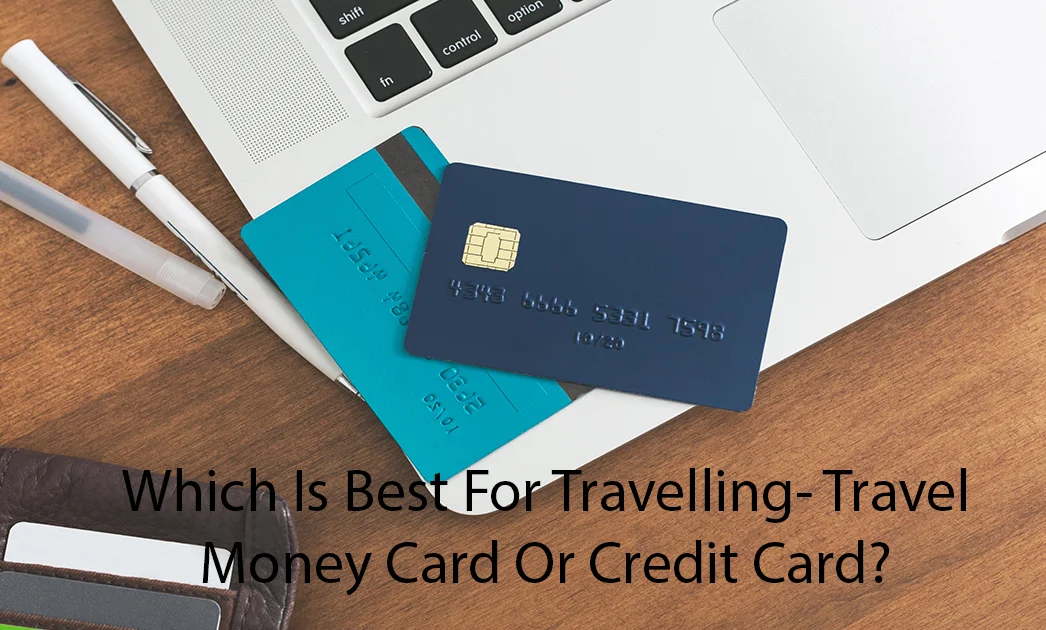Which is Best for Travelling- Travel Money Card or Credit Card?
Travel money cards and credit cards are two common options travelers use to pay for expenses when abroad. A travel money card is a prepaid debit card that you load with funds in different currencies before your trip. It offers the convenience of plastic without the risk of debt. Meanwhile, credit cards allow you to make purchases by borrowing money, but come with the downside of interest, fees, and potential overspending. When deciding between the two, it’s helpful to understand the key features and use cases of each.
Travel money cards, also known as prepaid travel cards, function similarly to debit cards. You pre-load your card’s account with funds in the currencies of the countries you plan to visit. When you make a purchase abroad, it draws straight from your prepaid balance. The card provider handles the foreign exchange conversion, and there are typically no international transaction fees. Travel money cards are chip-and-PIN enabled for enhanced security and wider acceptance overseas. Top providers include Travelex, AAA, and some major banks.
In contrast, credit cards allow you to make purchases on borrowed funds that you pay back later. This provides greater flexibility to spend as needed without carrying loads of cash, but requires paying interest on any unpaid balance. While many credit cards have no foreign transaction fees, they don’t offer built-in currency conversion. You simply make charges in the local currency which get converted by the card network using their exchange rate. Popular options for travel include Capital One and Chase Sapphire cards.
Which is generally better?
For most travelers, a travel money card is the safer choice for paying abroad compared to credit cards. By pre-loading a set amount of spending money, you can stick to a budget more easily and avoid credit card debt or overspending. Travel cards also provide peace of mind with lower fraud risk, access to emergency cash, and built-in currency exchange. However, frequent travelers may be better served by a premium credit card with robust rewards and protections. The best option depends on your travel habits, destination, and ability to responsibly manage credit card spending.
Benefits of Travel Money Cards
Pre-loaded with foreign currency
One of the biggest advantages of travel money cards is that you can pre-load them with funds in different foreign currencies before your trip. This allows you to lock in competitive exchange rates and rest assured the money is ready to use abroad. Rather than having to exchange currency after you arrive, you can have pesos, euros, pounds, etc. loaded based on your itinerary. Top travel card providers like Travelex let you hold balances in over 15 currencies. This prepaid structure helps facilitate spending in multiple countries.
No foreign transaction fees
Most travel money cards do not charge foreign transaction fees, which are typically 3% costs levied by banks on international card usage. By pre-paying your card in full, you can avoid sneaky fees charged on credit or debit card transactions made abroad. This will save you a significant amount over relying on cards with foreign fees. Plus, you don’t have to worry about monitoring charges in unfamiliar currencies, as your prepaid balance serves as a spending limit.
Good for budgeting
Travel money cards are essentially like digital traveler’s checks, allowing you to allocate a set budget for vacation spending. By pre-loading a specific amount tied to your itinerary’s estimated costs, you can easily stay within budget and avoid credit card overages. The prepaid nature gives you greater control and visibility into what you’re spending in each country. Some travel cards also let you set daily ATM withdrawal limits as an extra budgeting safeguard.
Lower risk of fraud or theft
Travel cards provide greater peace of mind when it comes to fraud protection and minimized loss if your card is lost or stolen. The prepaid structure limits your maximum possible losses to the amount you preloaded. You can report and freeze a stolen card faster without waiting for credit card statements. Many travel cards don’t display your full card number for added security against card skimmers. And chip-and-PIN enabled cards offer enhanced fraud prevention measures overseas.
Drawbacks of Travel Money Cards
Need to pre-load funds and estimate usage
Travel cards require you to pre-load estimated funds in different currencies before your trip. This involves forecasting your spending and exchange rate needs. Underestimating can leave you short of funds. Overestimating results in wasted leftovers, as most cards charge fees to get back unspent money. Doing the math ahead of time takes effort. You also need to fund the card upfront vs. paying as you go like with credit cards. However, some banks let you reload cards remotely if needed.
Unused funds may be wasted
Related to pre-loading, any funds left on your travel card after your trip can potentially go to waste. Many travel cards charge inactivity or closure fees if you don’t use up your balance within a set timeframe. For example, if you pre-loaded €500 for a trip but only spent €300, you could get hit with a €5 monthly inactivity fee to keep the card open. Be sure to understand the closure policies of any prepaid travel card.
Fees to withdraw cash
While travel cards allow free POS purchases abroad, getting cash from ATMs often incurs fees, similar to debit cards. Some cards charge a flat $5 fee per overseas cash withdrawal. Others charge a percentage, like 3% of the withdrawn amount. If you plan to rely on ATM access for cash, compare card fees and determine if it’s more cost effective to pay-as-you-go at the machine vs. pre-loading funds.
Not accepted everywhere
Though acceptance is improving, prepaid travel cards are not universally accepted like credit cards. Some merchants, especially smaller shops or vendors, may only take cash or local bank cards. Policies can also vary by country. Having backup payment methods is wise. That said, Visa and Mastercard prepaid travel cards offer excellent global acceptance—just be prepared for the occasional exception.
To maximize benefits and minimize pitfalls, carefully assess your expected spending and card usage. Travel money cards remain an excellent option—just be realistic when pre-loading funds and understand possible fees.
Benefits of Credit Cards
Accepted almost everywhere
One of the biggest advantages of using credit cards for travel purchases is their nearly universal acceptance around the world. Major networks like Visa and Mastercard are accepted at millions of merchants in hundreds of countries. Even many small shops, cafes, and vendors that only take cash will often accept major credit cards. This gives travelers flexibility and convenience to use a single payment method rather than relying on cash everywhere.
Can access your own funds
With a credit card, you aren’t limited to a pre-loaded amount of funds like travel money cards. As long as you have available credit, you can access your own spending money as needed without carrying lots of cash. This provides greater flexibility if your travel plans change or expenses exceed expectations. Of course, this convenience must be weighed against the risk of overspending. But used responsibly, it enables cash flow abroad.
Provides protections
Credit cards provide a bundle of consumer protections and fraud prevention tools. These include $0 fraud liability from unauthorized charges, ability to dispute claims, emergency card replacement, and enhanced security features like EMV chips. Issuers also monitor for identity theft and suspicious charges. This provides peace of mind using cards abroad where fraud risks are higher.
Earn rewards
Many credit cards offer attractive rewards programs on top of basic spending benefits. Popular options include cash back, points/miles for airline/hotel programs, and statement credits. Using a card with a rich rewards program for your international spending can effectively earn you a discount on travel expenses. Just be sure to understand points values and redemption options.
With the unmatched acceptance, flexible access to funds, fraud protections, and potential to earn perks, credit cards offer advantages for travelers who use them responsibly. However, it’s critical to compare costs like interest rates and international fees to ensure they outweigh the benefits.
Drawbacks of Credit Cards
Foreign transaction fees
One downside of using credit cards abroad is getting stuck with foreign transaction fees, usually around 3% of each international purchase. While some cards have eliminated these fees, many still charge them, which really adds up. For example, on just €1,000 of spending in Europe, a 3% foreign transaction fee would cost you an extra $30. These fees apply whether you’re paying in dollars or the local currency.
Higher fraud risk
Unfortunately, credit cards tend to carry more fraud risks when used internationally compared to travel money cards or cash. Skimming and cloning of card data is more common abroad. If your card is lost or stolen, unauthorized charges on your account could really rack up. While protections are available, it can be a headache dealing with fraudulent charges while traveling. Using chip cards and monitoring statements closely is key.
Relying on credit
Credit cards enable you to spend more than you have cash on hand for, which can promote overspending without a strict budget. It’s easier to swipe now and pay later, but this borrowing can lead to high interest charges down the road. The cycle of debt is easier to fall into, especially for big-ticket travel purchases. Make sure you can pay off balances in full.
Temptation to overspend
With no preset spending limit, it’s tempting to overspend on a credit card for things you may not necessarily need or budget for, like souvenirs. Travel often leads to pricey incidentals and activities that seem small at the time but add up. Without cash as a visual limit, it’s easier to overindulge. Be sure to track expenses diligently and have the discipline to live within your actual budget.
Tips for Choosing What’s Best for You
Consider your destination(s)
The country or region you’re traveling to should inform your decision between a travel money card and credit card. Certain destinations have better infrastructure for accepting cards, while others are still heavily cash-based. Research acceptance and risks for your specific destinations. E.g. a travel card may make more sense for rural parts of Europe vs. credit cards for major Asian cities.
Assess your spending habits
Consider your own spending habits and financial discipline. Are you good at sticking to budgets and resisting frivolous purchases? If so, a credit card could work. For those who tend to overspend, a prepaid travel card forces you to limit spending to your pre-loaded amount. Be realistic about your behavior.
Compare fees
Do a thorough fee comparison. Travel cards have minimal fees but may charge for ATM access or inactive balances. Credit cards could stick you with foreign transaction fees. Crunch the numbers for your expected spending and usage. A spreadsheet can help determine potential fee costs for each.
Weigh fraud protection
How much fraud protection you need depends on locations and activities. Adventure travelers may prefer a travel card’s limited loss potential. Road warriors who need strong dispute options are better off with credit card protections. Assess your personal risk tolerance and how much protection you require.
The best payment method depends on your destinations, budget, spending tendencies, and risk appetite. Analyze your specific situation, rather than relying on general assumptions. An informed decision will lead to the right travel money solution.
Recommendation on best option for most travelers
For most international travelers, a prepaid travel money card is the safest bet for paying abroad. The budgeting assistance, fraud protections, and avoidance of credit card debt make travel cards ideal for average vacations. Having a prepaid card as your primary payment method, supplemented by a small amount of cash and a credit card for emergencies, provides the best of both worlds.
That said, frequent jet-setters may be better served by a premium travel rewards credit card with strong fraud monitoring, points earning, and dispute resolution. But unless you travel extensively, a prepaid card tailored to your itinerary is usually the smarter choice for managing money abroad.




